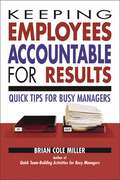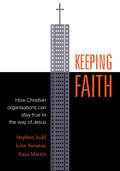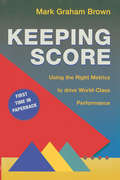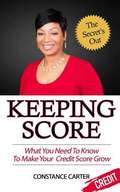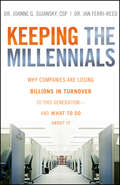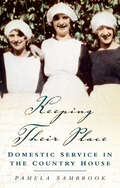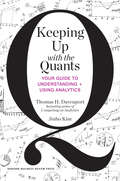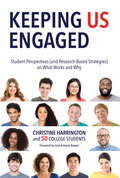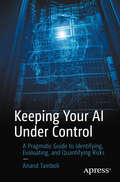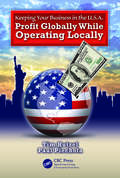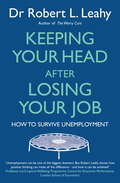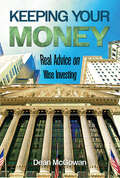- Table View
- List View
Keeping Employees Accountable for Results: Quick Tips for Busy Managers
by Brian Cole MillerAll managers want to hold their employees accountable for results, but few know how. Moving beyond the far-from-ideal annual performance review -- which only evaluates what has already occurred, and not what the manager wants to achieve -- Keeping Employees Accountable for Resultscontains checklists, how-tos, and other tools to manage performance on an ongoing basis. The book gives busy managers quick, step-by-step advice on: * Setting expectations * Monitoring progress * Giving feedback * Following through Light on theory and heavy on practical application, Keeping Employees Accountable for Results gives time-pressed managers the proven, practical information they need to help their people accomplish more."
Keeping Faith: How Christian Organisations Can Stay True to the Way of Jesus
by Stephen Judd John Swinton Kara MartinWe all can think of organisations that were established by Christians that are no longer recognisably Christian. In Keeping Faith, the authors outline the key components of organisational faithfulness – that is, what is needed for Christian organisations to stay true to the way of Jesus. They argue that the old reliance on statements of faith, or a set of Christian values, is insufficient. What is needed is a robust organisational theology that inhabits the enterprise’s structures, management, business policies, practices and relationships and is tailored to the purpose of the organisation.In this important book, you will find: a checklist to determine if your organisation is losing its faithfulness; an outline of some key components of organisational theology; examples, both positive and negative, of theological application in organisations; discussion questions for organisational reflection.With combined global experience in practical theology, running businesses and charities, and integrating faith and work, Judd, Swinton and Martin have created an important and essential book for every Christian organisation.
Keeping Finance Personal: Ditch the “Shoulds” and the Shame and Rewrite Your Money Story
by Ellyce Fulmore&“… a clear, approachable guide to help readers untangle their relationship with money, understand the systems and inequities that impact them, and reclaim financial independence.&”―Edgar Villanueva, bestselling author of Decolonizing WealthAn intersectional approach to personal finance from queer, neurodivergent personal finance educator and TikToker, Ellyce Fulmore. There&’s no magic formula for being &“good with money.&” The perfect budgeting spreadsheet or debt repayment plan will never address the root of your money issues. When Ellyce Fulmore started her journey with personal finance, she was drowning in $35K of debt, had $60 to her name, and avoided looking at her bank account. Her own &“aha&” moment came when she realized that the reason she and so many others have struggled with finances has little to do with being &“bad with money.&” Instead, it has everything to do how identity and lived experience affect financial behaviors. Now in Keeping Finance Personal, Ellyce offers a shame-free, trauma-aware approach that explores the complex, nuanced, and deeply personal relationship between your identity and your money. With chapters exploring topics such as finding safe spaces, personal values, relationship dynamics, family systems, and culture, it&’s clear this is not your typical finance book. Readers will engage with how their upbringing, sense of self, trauma, and mental health impact their decisions, and begin a journey to change their relationship with money. This book is for the woman facing sexism at her local bank, the neurodivergent person struggling with impulse spending, the young adult questioning societal expectations, the 2SLGBTQIA+ couple searching for a place to rent—all the people that don&’t fit into the mold that traditional finance advice is aimed at. Filled with interviews from a diverse range of voices, practical exercises, and tangible tips, Keeping Finance Personal provides a path to develop a healthy money mindset and create a life where financial stability and joy coexist.
Keeping Financial Records For Business
by Robert A. Schultheis Burton S. Kaliski Carol Sturzenberger Daniel H. Passalacqua Nancy LongKeeping Financial Records for Business 9E will give your students a broad knowledge of business operations and the basic skills they need to keep better financial records. The text contains a colorful graphic design and features that will capture students? interest, such as multicultural insights and interviews with individuals who use record keeping in their daily lives. A step-by-step approach to each new task makes it easier for students to master the job skills of record keeping.
Keeping Google "Googley"
by Boris Groysberg Alison Berkley Wagonfeld David A. ThomasThis case, set in 2008, examines how Google has worked to avoid potential negative byproducts of rapid growth such as bureaucracy, slow decision-making, lack of visibility, and organizational inconsistency. When the case protagonist, Kim Scott, started with Google in 2004, she wondered if she would still be there in several years as she liked small, entrepreneurial companies. In 2008, she was pleased that Google still had the same entrepreneurial energy that it had when she joined. She and her colleagues reflect on how Google has been able to maintain its culture as the company keeps doubling in size.
Keeping Google "Googley" (Abridged)
by Boris Groysberg Alison Berkley Wagonfeld David A. ThomasCase
Keeping HEROes Safe: How IT Can Manage the Risks Inherent in Employee-Driven, Technology-Based Innovations
by Josh Bernoff Ted SchadlerThere was a time, years ago, when IT security meant locking down your company's network and databases, putting everything behind a firewall, and giving only a few authorized people the password. That's no longer possible in a world in which your employees, armed with groundswell technologies like Facebook, Twitter, YouTube, and Flickr aren't just powerful-they're dangerous. In this chapter, authors Josh Bernoff-coauthor of "Groundswell"-and Ted Schadler address the risks inherent in companies powered by employee HEROes-Highly Empowered and Resourceful Operatives-who are using social technologies to turn themselves into a continuous force for innovation in serving customers. The authors explain that it's not IT's job to try to stop your employees from using social technologies. Instead, IT needs to keep them safe. This requires two changes. First, help HEROes and their managers assess, manage, and mitigate risks. Second, educate your employees about where the guardrails are in social media: 1) Put your name on everything you do; 2) Remember that you are an employee; and 3) Own up to mistakes and fix them. With compelling examples from Kodak, Domino's Pizza, and Cisco, this chapter is a must-read as you consider whether your company is ready to be HERO-powered. This chapter was originally published as Chapter 12 of Empowered: Unleash Your Employees, Energize Your Customers, and Transform Your Business
Keeping International Commitments: Compliance, Credibility and the G7, 1988-1995 (Transnational Business and Corporate Culture)
by Eleonore KokotsisThis study is the first to offer explanations for compliance with G7 commitments by identifying the patterns, explaining the causes and exploring the processes of this compliance from 1988-1995. It provides the only systematic review of the G7's compliance record in the post-Cold War globalizing system of the 1990s and in regard to important environment and development commitments that have often dominated the Summit's agenda during this third cycle of summitry. It draws on explanatory factors for Summit compliance from three bodies of international relations theory-including regime theory, concert theory and the recent extension of regime theory to embrace the effects of domestic political institutions.
Keeping Ontario Moving: The History of Roads and Road Building in Ontario
by Robert Bradford<p>A comprehensive history of roads and road-building in Ontario. <p>In this beautifully illustrated book, virtually every facet of the road building industry in Ontario is discussed, from labour relations to safety, politics, and financing. Follow the history of road-building technology from the first crude trails hacked through dense forests by homesteaders to the corduroy roads, planks roads, stone roads, macadam pavements, hot mix asphalt pavements, and concrete roads. See how the engineering and construction of bridges has progressed from the first jack pine logs placed across a stream to the complex structures that span international waters and thousands of rivers today. Follow the development of construction equipment from the first steam shovels and cable-operated machines of the late 1800s to diesel-powered machines in the 1940s and later hydraulics. Meet the companies that made the equipment and the people who sold and rented it. <p>From the 1930s forward the early story of roads is told largely by the people who lived and made the history. Over 120 contractors, engineers, government officials, and others were interviewed and the last eighty years of the industry’s history unfolds in the way they remember it. Share their memories and stories, some hilarious and some tragic, as they talk about their projects, their businesses, their successes, and their hardships.</p>
Keeping Patients Safe: Transforming the Work Environment of Nurses
by Institute of Medicine of the National AcademiesBuilding on the revolutionary Institute of Medicine reports To Err is Human and Crossing the Quality Chasm, Keeping Patients Safe lays out guidelines for improving patient safety by changing nurses working conditions and demands. Licensed nurses and unlicensed nursing assistants are critical participants in our national effort to protect patients from health care errors. The nature of the activities nurses typically perform – monitoring patients, educating home caretakers, performing treatments, and rescuing patients who are in crisis - provides an indispensable resource in detecting and remedying error-producing defects in the U.S. health care system. During the past two decades, substantial changes have been made in the organization and delivery of health care - and consequently in the job description and work environment of nurses. As patients are increasingly cared for as outpatients, nurses in hospitals and nursing homes deal with greater severity of illness. Problems in management practices, employee deployment, work and workspace design, and the basic safety culture of health care organizations place patients at further risk. This newest edition in the groundbreaking Institute of Medicine Quality Chasm series discusses the key aspects of the work environment for nurses and reviews the potential improvements in working conditions that are likely to have an impact on patient safety.
Keeping Races in Their Places: The Dividing Lines That Shaped the American City
by Anthony W. Orlando"A book perfect for this moment" –Katherine M. O’Regan, Former Assistant Secretary, US Department of Housing and Urban Development More than fifty years after the passage of the Fair Housing Act, American cities remain divided along the very same lines that this landmark legislation explicitly outlawed. Keeping Races in Their Places tells the story of these lines—who drew them, why they drew them, where they drew them, and how they continue to circumscribe residents’ opportunities to this very day. Weaving together sophisticated statistical analyses of more than a century’s worth of data with an engaging, accessible narrative that brings the numbers to life, Keeping Races in Their Places exposes the entrenched effects of redlining on American communities. This one-of-a-kind contribution to the real estate and urban economics literature applies the author’s original geographic information systems analyses to historical maps to reveal redlining’s causal role in shaping today’s cities. Spanning the era from the Great Migration to the Great Recession, Keeping Races in Their Places uncovers the roots of the Black-white wealth gap, the subprime lending crisis, and today’s lack of affordable housing in maps created by banks nearly a century ago. Most of all, it offers hope that with the latest scholarly tools we can pinpoint how things went wrong—and what we must do to make them right.
Keeping Score: Using the Right Metrics to Drive World Class Performance
by Mark Graham BrownIn Keeping Score, the author contends that metrics must be all-encompassing. They must focus not just on the present, but need to consider the past and future. They also must consider the needs of all participants, including customers, shareholders, and employees. Still one must know exactly what to measure, as measuring everything can be more damaging than measuring nothing. Taking a balanced Baldrige approach, this book shows how to evaluate current approaches to measurement and pinpoint false measurements. It covers the selection of financial metrics, ways to measure employee and customer satisfaction, and methods to track performance and measure quality.
Keeping Score: What You Need To Know To Make Your Credit Score Grow
by Constance CarterIncrease your credit score quickly: Learn the secrets credit repair consultants & attorneys use to repair credit. Get on track to purchase your dream home, buy your dream car, or reduce your interest rate
Keeping The Millennials
by Jan Ferri-Reed Joanne Sujansky"This is a great book and a must-read for anyone who wants tounderstand the young people who are now or will soon join the workforce. It'sone of the most useful value-added books about the Millennial generation."--Warren Bennis, Distinguished Professor of Management, University of Southern California,and author of On Becoming a Leader"Are you confused trying to understand the younger generation? Keeping the Millennials explores this fascinating generation raised withtechnology and the challenges they bring to the workplace. Read this great book andlearn how to attract, hire, and retain this dynamic new generation!"--Marshall Goldsmith, New York Times and Wall Street Journal #1 bestselling author of What Got You Here Won't Get You There and Succession: Are You Ready?"Keeping the Millennials is a lively and insightful book that'sessential reading for every leader who aspires to enlist the hearts, minds, andspirits of a highly talented new generation that demands cool workplaces but is reluctant to make long-term commitments. Weaving together compelling cases and relevant research with illustrative examples and practical tips, Joanne Sujansky and Jan Ferri-Reed havewritten a balanced and indispensable guide to recruiting, retaining, and developing the workforce that will drive the future of our organizations and our economies."--Jim Kouzes, bestselling coauthor of The Leadership Challenge"I love this book!!! It's fresh as a breaking news flash and as fun to read as yourfavorite blog! Definitely rates an A+ as timely, targeted, and terrific. All managers will clearly see themselves and their employees in crisp new perspectives...and can easily latch on to precise tools to make their organization more competitive in a turbulent reality."--Morris Massey, PhD, creator of the What You Are Is... video training series, EnterpriseMedia.com"Corporations are always concerned about return on investment. Drs. Sujansky and Ferri-Reed have made a clear case about the bottom-line value of keeping Millennials--and creating productive workplace cultures for all generations. This is amust-read for anyone concerned about the retention of these key employees."--Jack Phillips, PhD,Chairman, ROI Institute
Keeping Their Place: Domestic Service in the Country House 1700-1920
by Pamela A SambrookIn 1851 there were over a million servants in Britain. This book reveals first-hand tales of put-upon servants, who often had to rise hours before dawn to lay fires, heat water and prepare meals for their employers, and then work into the small hours. Yet there are also heartwarming stories of personal devotion, and reward, and of how the servants enjoyed themselves in their time off.There are moments of great poignancy as well as hilarity: a steward's dawning realisation that the housekeeper he befriended is a thief; a young footman chasing a melon as it rolls through a castle's corridors into the moat; the smart manservant weeping at the station as he bids farewell to his mother. This was an era when footmen were paid extra for being six foot or over, and female servants had to wear black bonnets to church.Drawing on letters, diaries, and autobiographies Keeping Their Place provides a vivid insight into the day-by-day lives of country house servants between the eighteenth and twentieth centuries.
Keeping Up with the Quants
by Thomas H. Davenport Jinho KimWhy Everyone Needs Analytical SkillsWelcome to the age of data. No matter your interests (sports, movies, politics), your industry (finance, marketing, technology, manufacturing), or the type of organization you work for (big company, nonprofit, small start-up)-your world is awash with data.As a successful manager today, you must be able to make sense of all this information. You need to be conversant with analytical terminology and methods and able to work with quantitative information. This book promises to become your "quantitative literacy" guide-helping you develop the analytical skills you need right now in order to summarize data, find the meaning in it, and extract its value.In Keeping Up with the Quants, authors, professors, and analytics experts Thomas Davenport and Jinho Kim offer practical tools to improve your understanding of data analytics and enhance your thinking and decision making. You'll gain crucial skills, including: How to formulate a hypothesis How to gather and analyze relevant data How to interpret and communicate analytical results How to develop habits of quantitative thinking How to deal effectively with the "quants" in your organizationBig data and the analytics based on it promise to change virtually every industry and business function over the next decade. If you don't have a business degree or if you aren't comfortable with statistics and quantitative methods, this book is for you. Keeping Up with the Quants will give you the skills you need to master this new challenge-and gain a significant competitive edge.
Keeping Us Engaged: Student Perspectives (and Research-Based Strategies) on What Works and Why
by Christine Harrington FO 50 College StudentsThis book offers faculty practical strategies to engage students that are research-grounded and endorsed by students themselves. Through student stories, a signature feature of this book, readers will discover why professor actions result in changed attitudes, stronger connections to others and the course material, and increased learning.Structured to cover the key moments and opportunities to increase student engagement, Christine Harrington covers the all-important first day of class where first impressions can determine students’ attitudes for the duration of the course, through to insights for rethinking assignments and enlivening teaching strategies, to ways of providing feedback that build students’ confidence and spur them to greater immersion in their studies, providing the underlying rationale for the strategies she presents. The student narratives not only validate these practices, offering their perspectives as learners, but constitute a trove of ideas and practices that readers will be inspired to adapt for their particular needs.Conscious of the changing demographics of today’s undergraduate and graduate students – racially more diverse, older, and many employed – Harrington highlights the need to engage all students and shares numerous strategies on how to do so. While many of the ideas presented were used by faculty teaching face to face classes, a number were developed by faculty teaching online, and the majority can be adapted to virtually any teaching environment. Based on student-centered active learning principles, structured to allow readers to quickly identify practices that they may need in particular instances or to infuse in a course as a whole, and presented without jargon, this book is a springboard for all faculty looking for ideas that will engage their students at any level and in any course.
Keeping Your AI Under Control: A Pragmatic Guide to Identifying, Evaluating, and Quantifying Risks
by Anand TamboliMuch of our daily lives intertwine with artificial intelligence. From watching movies recommended by our entertainment streaming service, to interacting with customer service chatbots, to autotagging photos of friends in our social media apps, AI plays an invisible part in enriching our lives. While AI may be seen as a panacea for enterprise advancement and consumer convenience, it is still an emerging technology, and its explosive growth needs to be approached with proper care and preparation. How do we tackle the challenges it presents, and how do we make sure that it does precisely what it is supposed to do?In Keeping Your AI Under Control, author Anand Tamboli explores the inherent risk factors of the widespread implementation of artificial intelligence. The author delves into several real-life case studies of AI gone wrong, including Microsoft’s 2016 chatbot disaster, Uber’s autonomous vehicle fatally wounding a pedestrian, and an entire smart home in Germany dangerously malfunctioning because of one bad lightbulb. He expertly addresses the need to challenge our current assumptions about the infallibility of technology. The importance of data governance, rigorous testing before roll-out, a chain of human accountability, ethics, and much more are all detailed in Keeping Your AI Under Control. Artificial intelligence will not solve all of our problems for good, but it can (and will) present us with new solutions. These solutions can only be achieved with proper planning, continued maintenance, and above all, a foundation of attuned human supervision. What You Will LearnUnderstand various types of risks involved in developing and using AI solutionsIdentify, evaluate, and quantify risks pragmatically Utilize AI insurance to support residual risk managementWho This Book Is ForProgressive businesses that are on a journey to use AI (buyers/customers), technical and financial leaders in AI solution companies (solution vendors), AI system integrators (intermediaries), project and technology leads of AI deployment projects, technology purchase decision makers, CXOs and legal officers (solution users).
Keeping Your Business Organized: Time Management & Workflow (Young Adult Library of Small Business an #10)
by James FischerAre you interested in having your own business? Today, young people have never had more opportunities to build new and exciting businesses. Before you start your business, you'll need to know the basics, though. Without organization, many businesses don't do as well as they could. If you don't keep your work schedules organized, you can quickly find things getting out of control. In Keeping Your Business Organized: Time Management & Workflow, you'll learn how to keep on schedule, and how you can keep your business running smoothly.
Keeping Your Business in the U.S.A.: Profit Globally While Operating Locally
by Tim Hutzel Paul PiechotaHere to bring back the pride, confidence, and jobs that "Made in the U.S.A." once generated Keeping Your Business in the U.S.A.: Profit Globally While Operating Locally shows American enterprises how to survive and prosper while keeping their manufacturing base within the United States. It tells the stories of three manufacturing companies that hav
Keeping Your Head After Losing Your Job: How to survive unemployment
by Dr Robert L. LeahyAlthough the current economic crisis creates a sense of urgency, we have always had and will always have a large number of people who are unemployed. For many, it is the most difficult time that they have ever faced. Without help, the unemployed face an increased risk of binge drinking, depression, anxiety and suicide. For many, there is a decreased quality of mental health, life satisfaction and objective physical wellbeing. Most feel alone and helpless.Dr Robert Leahy has worked with many unemployed people over the years, examining the psychological consequences of unemployment and exploring ways to help people cope with the emotional fallout of losing their job. This book gives readers psychological tools to handle their period of unemployment and simple, self-help strategies that can be used immediately to help them feel better and act better. The book draws on cognitive behavioural therapy (CBT) as well as practices such as mindfulness to help readers boost their self-esteem and confidence, decrease anxiety and feelings of helplessness, and develop resiliance and strength going forward.
Keeping Your Money: Real Advice on Wise Investing
by Dean McGowanYour Money Is Yours for the Keeping! Dean McGowan is no stranger to how confusing and overwhelming the world of investing can be for most of us. Over his decades-long journey of managing his clients' investments, McGowan has observed where others go right-or very wrong-when attempting to build their wealth. In Keeping Your Money, McGowan breaks down in simple terms the best investment practices and, more importantly, what to avoid when investing your hard-earned savings. Growing up in East Texas at a time when even children were expected to contribute financially, McGowan has always known the value of a dollar. This formative experience would later equip him with the self-management skills to put himself through college and realize his dream of working in wealth management. In Keeping Your Money you will learn a multitude of timeless principles, such as: DON'T sell at the lows or buy at the highs DO diversify your investments DON'T buy on a margin DO invest for the long term DON'T speculate on the market DO research every investment opportunity Illustrating his points with anecdotes from his many decades of managing client investments, along with the amusing and horrifying investment debacles that have beset figures from pop culture and history, McGowan offers an educational and engaging guide to smart investing. The time is now to give your hard-earned wealth the best possible chance to take root and keep on growing through the years ahead.
Keeping it in the Family at Hayden Saw Company
by V. G. Narayanan John MaskoIn 2019, Board Chair and third-generation shareholder Helen Fullerton was preparing for a meeting to discuss Ohio-based Hayden Saw Company's (Hayden) future as a family business. As the company entered its fifth decade, the Hayden family was dealing with three distinct pressures. First was the question of how to represent shareholders equitably in a way that would enable the family to move past its history of friction and estrangement. The second question was how to ensure a talented pipeline of family members working at the company as the family dispersed across the U.S. Third and relatedly, was the question of how to ensure informed family representation on the company's board to support its independent directors. To address these pressures, Fullerton had commissioned a family business consultant to generate a series of proposals. The consultant had come back with comprehensive ideas for a shareholders' council, a family office, family employment tracks, and a shareholder director process. Now it was time for Fullerton to review the proposals and decide how to move forward.
Keeping on Track: Maintaining Control
by Harvard Business Review PressKeeping project team members motivated and focused is vital to the success of any project. This chapter focuses on three key responsibilities of project managers that allow them to master conflict and handle problems that might arise. Communication is an essential system that must be in place before an effective project management model is created.
Keeping the Best: Essential Retention Strategies
by Harvard Business Review PressDistilling recent research findings, this chapter explores why employee retention is valuable in terms of customer satisfaction, turnover costs, and business performance. It then provides eight practical steps to improving retention.
